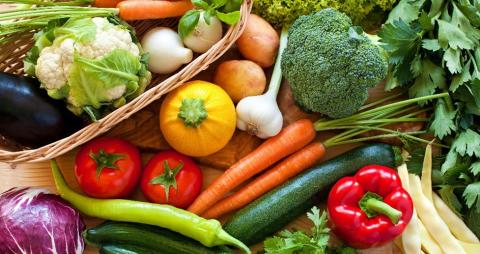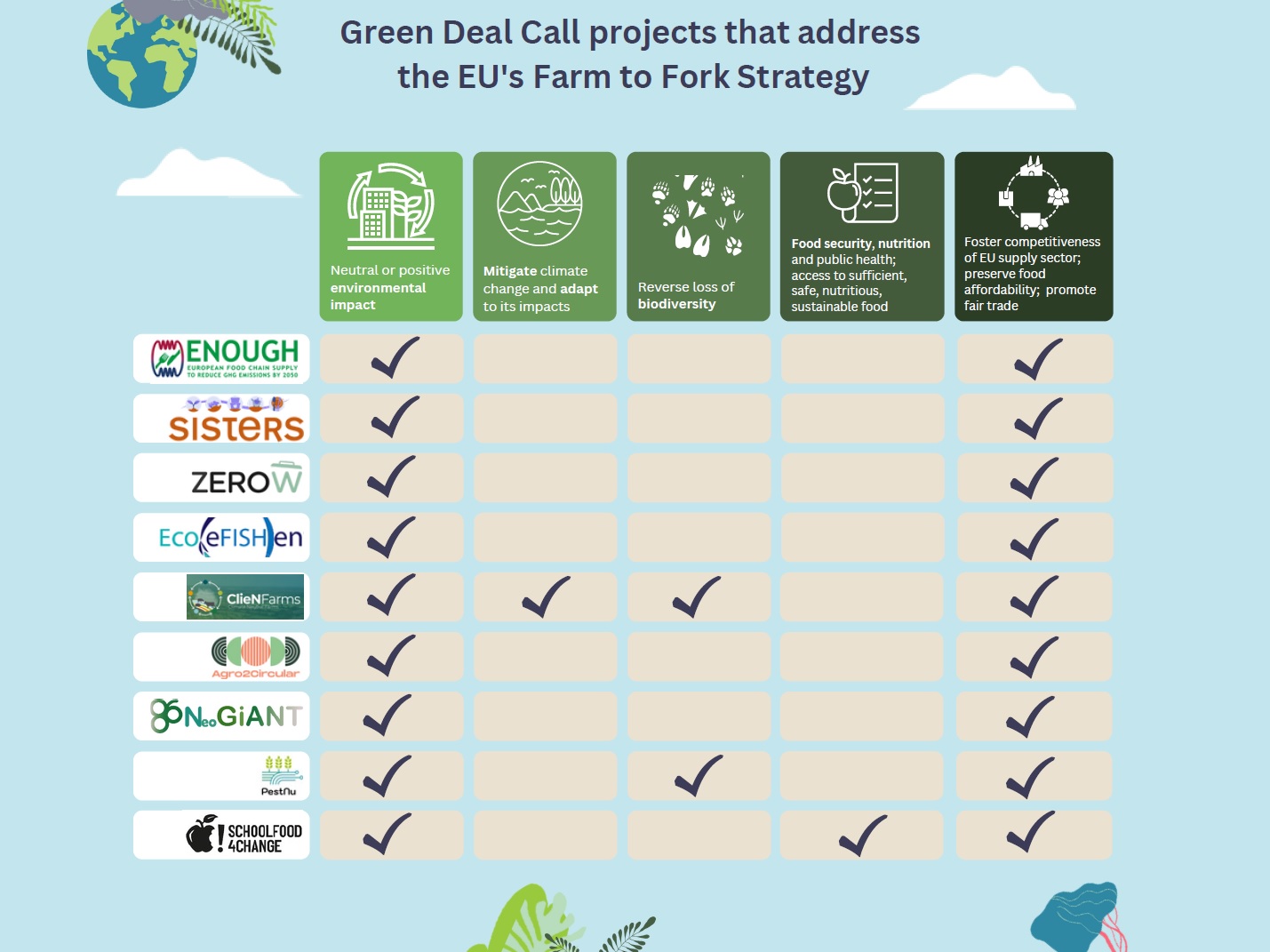Details
- Publication date
- Source
- Green Deal Projects Support Office
In this article, we will be exploring the external challenges that the EU’s Farm to Fork Strategy is facing and how some of the Green Deal Projects are at the forefront of achieving its objectives.
The Farm to Fork strategy (F2F) is at the heart of the European Green Deal, aiming to make food systems fair, healthy and environmentally friendly. Launched in May 2020, the strategy seeks to transform the way food is produced, processed, distributed, and consumed in the European Union (EU). The strategy is a critical component of the EU’s efforts to achieve its climate and biodiversity goals and ensure the long-term viability of its agricultural sector.
The COVID-19 pandemic highlighted the fragility of our food systems and the urgent need for redesigning them to ensure resilience. Almost a third of global greenhouse gas emissions are created by our food systems. Our existing food systems contribute to biodiversity loss and can have negative impacts on health (due to both under and over-nutrition). Moreover, the economic returns for primary producers are not equitable. To build resilience in our food systems, we must redesign them to be sustainable.
Transitioning to a sustainable food system brings benefits not only to our environment and society but also presents new opportunities for all stakeholders in the food value chain. By leveraging new technologies, scientific discoveries, and public awareness, stakeholders can jointly contribute to building sustainable food systems for the future.
According to the F2F strategy, research and innovation play a crucial role in hastening the shift towards a sustainable, healthy, and inclusive food system. This objective aligns with the overarching aim of the Green Deal and its associated projects, which tackle the entire food system, from primary production to end consumption.
For issues related to food waste, flexibility is essential among Member States, and their regulatory authorities should work collaboratively with food chain operators, farmers, manufacturers, retailers, and consumers. Food production, consumption, and waste should not be viewed in isolation, but rather necessitate a comprehensive and integrated approach, which can be challenging to execute. Several food projects under the Green Deal, such as SISTERS, ClienFarms, ENOUGH and ZeroW, take a holistic view of the sector/value chain. This approach aims to establish a sustainable production system that enhances ecosystem services, food security, human welfare, and opportunities for decent employment. Agriculture, fisheries, and aquaculture can all contribute significantly to healthy and sustainable food, and social partners can play a critical role in ensuring its sustainability.
The four key areas of the strategy are illustrated below:

The underlying aims of the F2F Strategy in accelerating our transition to a sustainable food system include:
- having a neutral or positive environmental impact
- helping to mitigate climate change and adapt to its impacts
- reversing the loss of biodiversity
- ensuring food security, nutrition, and public health – making sure that everyone has access to sufficient, safe, nutritious, sustainable food
- preserving the affordability of food while generating fairer economic returns, fostering the competitiveness of the EU supply chain and promoting fair trade
The following matrix maps out the aims of the F2F strategy that the Green Deal Call projects are helping to address (click to enlarge image):
The matrix illustrates that all of the Green Deal Call food projects are aligned with fostering the competitiveness of the EU supply chain and preserving the affordability of food. Notable projects that have contributed to creating a sustainable and accessible food system are noted below:
- ClienFarms is at the forefront of developing a sustainable and accessible food system by collaborating with farmers to co-design innovative solutions that address pressing environmental concerns. Through the use of cutting-edge technology and data-driven approaches, ClieNFarms aims to reduce greenhouse gas emissions and increase carbon sequestration and storage by at least 50% by 2050. By working hand-in-hand with agricultural communities, ClieNFarms is able to tailor its solutions to local contexts, empowering farmers to adopt practices such as precision agriculture, agroforestry, and regenerative farming. These environmentally conscious methods increase the overall productivity and resilience of farming systems, as well as contributing to mitigating climate change.
- PestNu is revolutionizing the agricultural landscape through the development and implementation of innovative technology and agro-ecological practices. By conducting extensive field-testing and demonstrating the efficacy of their solutions, PestNu helps farmers significantly reduce their reliance on pesticides and fertilizers, ultimately lowering their environmental footprint. Using cutting-edge technologies, such as drones and remote sensing, PestNu enables farmers to monitor their crops with unprecedented precision, allowing for targeted interventions and minimizing the need for harmful chemicals. Furthermore, PestNu promotes the adoption of agro-ecological practices, such as integrated pest management, cover cropping, and crop rotation, which not only enhances the health of the ecosystem but also bolsters crop resilience and yield. These pioneering efforts are paving the way for a more sustainable and accessible food system that benefits both people and the planet.
- SchoolFood4Change is playing a pivotal role in fostering a sustainable and accessible food system by promoting a shift towards healthy and environmentally friendly diets on a societal scale. By targeting the younger generation, SchoolFood4Change has successfully impacted over 3,000 schools and 600,000 school children across 12 EU countries. Through its comprehensive approach - which encompasses educational initiatives, hands-on workshops, and the implementation of sustainable meal plans, SchoolFood4Change is cultivating an appreciation for nutritious, plant-based, and locally sourced food among students. By instilling these values early on, the project is empowers children to make informed dietary choices that not only benefit their health but also contribute to the well-being of the planet. This transformative movement serves as a catalyst for change, inspiring communities, policymakers, and food providers to join the collective effort towards a more sustainable and accessible food system for all.
Let’s now explore the significance and urgency of this in the context of the wider challenges that the F2F strategy faces.
European energy and food security in recent years

Two years have passed since the European Commission unveiled its F2F Strategy. Although the initiative has made considerable progress, the recent war in Ukraine has disrupted European energy and food security, leading to a shift in priorities. Agri-food trade has been significantly impacted due to the disruptions in Ukrainian supply chains, as well as revised trading relations with Russia, who were a strong trading partner prior to the conflict . The F2F strategy is indeed sensitive to the geo-political landscape in Europe. Such interregional dependencies underline the need for systemic changes towards sustainability of food systems.
Experts have noted the need for the improved coherence of food systems, environmental and climate objectives, agriculture subsidies, and trade policies to achieve these goals. However, they also caution that the current market signals are mixed and undermine the achievement of any of these objectives. They argue that the F2F initiative, while considered to be on hold, is still the right way forward, but with the urgent need for adjustments and realignment to explain and clarify its long-term objectives for transformation, ecological restoration, and economic competition for Europe’s future.
Given its significant influence on global agricultural trade, the EU’s internal consumption has a major impact on the sustainability of food systems worldwide. Although the EU is the number one exporter of high-value agri-food products (such as wine and chocolate), it is a net importer in terms of calories, nutrients, and protein from low-value, raw products such as cocoa, fruits and soybeans. This heavy reliance on many of the agri-food commodities the EU imports is at the expense of tropical deforestation and the loss of natural ecosystems.
Despite this, EU agri-food producers have warned against a trade-off between environmentally sustainable practices and ensuring adequate food production levels and food security. They argue that sustainability requirements should be carefully designed to not disrupt agricultural production. In this context, innovation, legislative, and financial support are critical to helping farmers produce food in a sustainable manner. Overall, a renewed focus on sustainable agriculture is necessary for the EU to maintain its position as a global leader in agricultural production while also protecting the environment and ensuring food security.
Food affordability and accessibility: A more pressing concern than food security?
Panellists at the SDSN co-convened EU policy workshop in June 2022 argue that food security may not be a major threat within the EU and instead, food accessibility and affordability pose significant challenges for the region. The rising cost of food has led consumers to choose cheaper options with a negative impact on both health and the environment. As such, introducing fairer, “true prices” has been seen as a positive measure to address this issue. However, the feasibility of this strategy is now being debated given that increasing food prices are already causing accessibility and affordability concerns.
The EU's reliance on imported gas to produce pesticides and fertilisers from Ukraine and Russia is a significant factor in determining the feasibility of introducing fairer prices. The F2F strategy aims to reduce fertiliser use, which could have an impact on stabilising prices. Still, this goal also raises questions about the EU’s self-sufficiency when it comes to agricultural inputs.
Moreover, the COVID-19 pandemic has highlighted the vulnerabilities in the EU’s food systems. As a result, the need for resilient, sustainable and locally sourced food supply chains has become more evident. The pandemic has shown the importance of strengthening local food systems, reducing dependency on imports, and supporting small-scale farmers. Therefore, the EU must focus on building more resilient food systems that prioritise food accessibility and affordability while ensuring sustainability and environmental protection. This would require a coordinated effort from policymakers, producers, and consumers.
For more information on the Green Deal projects focused on sustainable food systems, visit the Food and Health Working Group projects.


